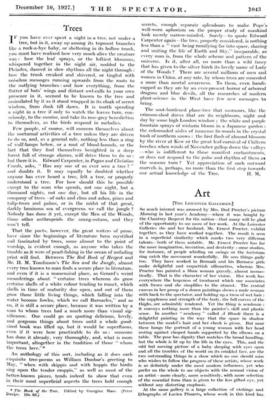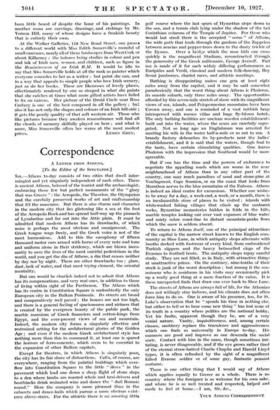Art
[TIIE LEICESTER GALLERIES.]
SO much interest was aroused by Mrs. Dod Procter's picture Morning in last year's Academy—where it was bought by the Chantrey Bequest for the nation—that many will be glad - of the opportunity to see more of her work. At the Leicester Galleries she and her husband, Mr. Ernest Procter, exhibit together, as they have worked together. The result is seen in a superficial similarity which marks two very different talents—both of them notable. Mr. Ernst Procter has far the more imagination, invention, and dexterity : some studies, for instance, of people whirling on swings or the teetotum ring catch the movement wonderfully. He sees things gaily too. They have worked in Burmah and his Burmese girls make delightful and coquettish silhouettes, whereas Mrs. Procter has painted a Shan woman gravely, almost monas- tically. That is the character of her vision. Her work has everywhere the largeness of treatment which one associates with fresco and she simplifies to the utmost. The central canvas in her group of a dozen paintings shows a nude woman with back to the spectator, and holding up a tress of wet hair : the suppleness and strength of the body, the full curves of the thighs, are admirably rendered. Yet the thing is academic : It conveys nothing more than the painter's skill and plastic sense. In another " academy " called A Blonde there is a delightful painting in the way that the space in shadow between the model's hair and her cheek is given. But near these hangs the portrait of a young woman with her head resting against clasped hands supported by the elbows on a table. The pose has dignity that matches the broad handling, but the whole is lit up by the life in the eyes. This, and the odd but moving picture of a baby sleeping with eyes open and all the troubles of the world on its crinkled face, are the two outstanding things in a show which no one should miss Who wishes to follow the progress of these artists, whose work is so definitely under the most modern influences, yet who prefer on the whole to see objects with the normal vision of an artist—more clearly, more sensitively, with more selection of the essential form than is given to the less gifted eye, yet without any distorting emphasis.
At the same gallery is a large collection of etchings and lithographs of Lucien Pissarro, whose work in this kind has , been little heard of despite the fame of his paintings. In another room are carvings, drawings, and etchings by Mr. Vernon Hill, many of whose designs have a freakish beauty that is entirely their own.
At the Walker Galleries, 118 New Bond Street, one passcs to a different world with Miss Edith Somerville's roomful of small canvases, nearly all of them landscapes from West Cork or about Killarney: the balance being studies in colour and pen and ink of Irish men, women, and children, such as figure in the Reminiscences of an Irish R.M. It would be idle to say that Miss Somerville holds at all the rank as painter which everyone concedes to her as a writer ; but paint she can, and in a way that appeals to simple people who love Irish scenery, just as do her books.. These are likenesses of lovely places, affectionately rendered by one so steeped in what she paints that she catches at times what more gifted artists have failed to fix on canvas. Her picture of the Druid Circle near Ross Carbery is one of the best composed in all thegallery ; but also it has not only the shapes and colours of an Irish hill-side ; it gets the pearly quality of that soft western air. Those who like pictures because they awaken remembrance will find all the chords of memory skilfully played on here ; and what is more, Miss Somerville offers her wares at the most modest











































 Previous page
Previous page